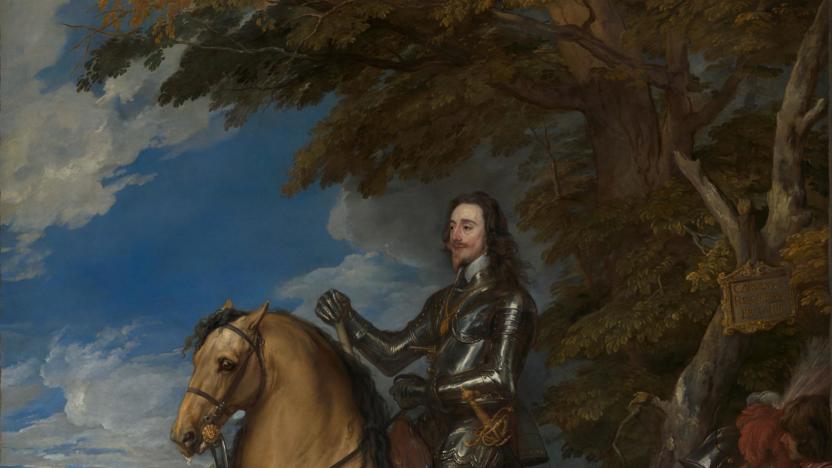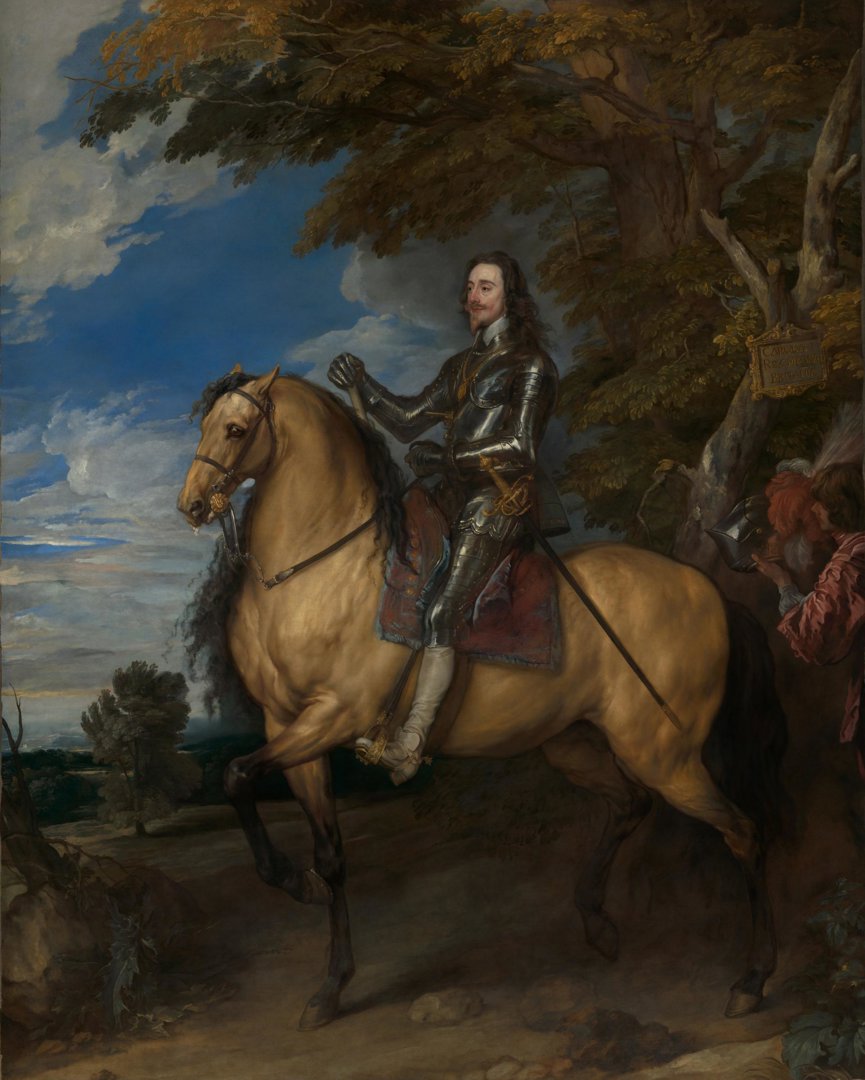Anthony van Dyck's 'Equestrian Portrait of Charles I'
Audio description
This is a description of the 'Equestrian Portrait of Charles I' by Anthony van Dyck, painted between 1638 and 1639. It is in oils, about three and a half metres high and nearly three metres wide. The frame is dark, with a gilded finish.
Set in the English countryside, the painting depicts Charles I of Great Britain on a muscular, tan-brown horse, ready for battle. They dominate the centre of the composition, side on to us, turned towards the light that streams in from the left. The landscape surrounding them is dull in comparison. Dressed in shimmering silver armour, Charles sits on his steed and gazes out, observing his kingdom. He appears calm, his long dark hair flows in the breeze, almost concealing a small pearl earing which hangs from his left ear. He has a pointed beard, curled moustache, and ruddy complexion.
The king wears a gold chain with an oval pendant around his neck. This is the insignia of the Order of the Garter – the oldest and most prestigious order of chivalry. A thin sheathed sword hangs at his side, pointing towards the rear of the horse. Its handle is ornate and gleams gold. With his right hand, he clasps a baton of command, demonstrating his senior military rank, whilst in his left hand he holds the reins of the horse, keeping the beast under close control.
The horse is powerful and foams at the mouth with a wild look in its eye. It’s muscular, in contrast to Charles’ slender leg against its flank. It is thought that Charles suffered with rickets as a child, resulting in weakened legs. However, the horse implies his strength as a ruler. Its dark, curly mane tumbles down its arched neck, mimicking its master’s hair. It obediently lifts its left hoof off the ground – poised and ready for the next command. Charles displays effortless control of his steed, reflecting his desire to keep a tight grip on his realm.
The horse stands on a beige, well-trodden path scattered with small rocks. On the left of the painting, the English countryside stretches off into the distance. The sky above is bright blue with swirling white clouds, tinged with orange, suggesting that the sun will soon set. In contrast, the right-hand side of the composition is darker – a tall elm tree climbs the edge of the painting, and branches covered in leaves stretch out above the King’s head. The leaves are beginning to yellow; autumn is on its way.
Almost hidden in the shadows, an ornately decorated tablet inscribed in Latin hangs from the tree trunk, serving as a reminder that this is ‘Charles I, King of Great Britain’. At the time Great Britain consisted of England, Wales and Scotland. Below the inscription, the upper body of an attendant is just visible, emerging from the right. Considerably lower than Charles, he presents the king with his silver helmet, complete with a plume of red feathers. Charles pays no attention to the offering – his gaze is fixed forwards, focused on what’s to come.
The artist, born in Antwerp, was Charles’ official painter. Van Dyck had great influence on English portraiture for years, creating many for Charles’ Court. Renowned for his detail, Van Dyck rendered his sitters in a realistic manner but also with such grandeur as to provoke a sense of inferiority in the viewer.
Van Dyck has immortalised Charles as composed, powerful and in control, a different king to that spoken of in history books - a reminder that things are perhaps not always what they seem.
When this portrait was painted, Charles was on the verge of war with Scotland, and just a few years later, he’d be at war with his own Parliament. Years of bloody battles finally resulted in Charles I being executed at Whitehall for treason. Charles was ‘King of Great Britain’ no more, and England was declared a Republic.


